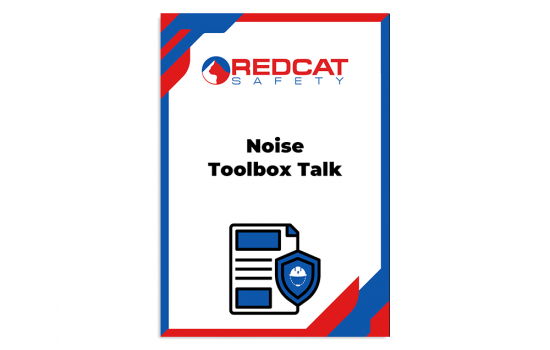About this Noise Toolbox Talk
This noise toolbox talk gives some practical guidance on how noise affects hearing, how to identify and assess noise exposure and how to control health and safety risks arising from excessive noise.
Noise is a common hazard in the workplace, and it can be a serious health and safety concern. It’s important to be aware of the potential to damage hearing and to take steps to protect employees from exposure to loud noise.
What is Excessive Noise?
Excessive noise is the noise that exceeds the maximum daily exposure limit. It is the noise that may cause permanent hearing loss because of its intensity, duration and/or frequency distribution or if the noise disturbs cognitive or physiological functions.
Excessive noise in the workplace can be a high-level risk and may result in noise-induced hearing loss, which can be permanent.

Under the various regulations a process needs to be established to familiarize workers with the following:
- What levels of noise are, the range of health effects due to noise, and the social implications.
- The exposure to noise in their particular workplace (e.g. over 85 decibels).
- The general and specific control measures which are necessary to protect them and other persons who may be affected by their work.
- The noise at work policy and program.
- Arrangements for reporting defects likely to cause excessive noise.
- When and how to use personal hearing protection and their proper care and maintenance.
- The statutory responsibilities of employers and employees.
What are the Temporary Effects of Excessive Noise?
The temporary effects of excessive noise exposure are ringing, buzzing, or roaring sounds in the ears and/or muffled hearing.
What are the Permanent Effects of Excessive Noise?
- Constant ringing in the ears (tinnitus) resulting in hearing damage.
- Trouble hearing high-frequency sounds such as the phone ringing.
- Speech consonants such as ‘S’, ‘T’, ‘K’ and ‘C’ may be hard to hear.
- You may have to turn the television or radio volume up to hear it clearly.
Note: Workplace noise should be assessed, monitored and controlled to ensure compliance with statutory requirements.
Noise Controls
- Identify if noise levels are excessive or a problem at work.
- Consult with workers and discuss lines of defense.
- Assess the risks to health and safety from noise exposure.
- Develop a hearing conservation program.
- Introduce noise dampening control measures (e.g. (engineering controls such as sound barriers and administrative controls).
- Provide workers with training and information about noise and the amount of time exposed.
- If warranted, provide audiometric hearing tests.
Hearing Protection
- Hearing protectors can be very effective but, only if it fits properly.
- A significant noise reduction of 10 – 24 decibels can be achieved if the correct hearing protectors are selected and worn.
- There are two different types of protection – ear plugs and earmuffs.
What Do I Need to Do to Protect My Hearing?
- Follow the instructions given to protect you from the risks associated with hazardous noise exposure.
- Use hearing protection.
- Maintain your hearing protection (PPE) in good condition.
- Follow any noise advisory signage at the workplace.
Why Become a Member of Redcat Safety and Download this Noise Toolbox Talk?
This toolbox talk on noise can help raise awareness about the hazards associated with excessive noise in the workplace and prevent hearing loss. Employees gain a better understanding of the potential risks to their hearing health and overall well-being.
After downloading this noise toolbox talk you will be able to:
- Very easily edit and customize the template to create your own noise safety toolbox talk.
- Apply your own style, format and brand to the noise toolbox talk.
- Use it in any industry or sector regardless of size or type of organization.
Availability and Use of this Noise Toolbox Talk
- This noise toolbox talk template is accessible to you right now by clicking the ‘Become a Member Now’ button.
- The toolbox talk will be delivered to you in fully editable Microsoft Word format for immediate and full use in your business.
- There are no membership auto-renewals, contracts or ongoing costs.

If you can find HSEQ resources that are of better value than what your Redcat Safety Membership offers, we will REFUND YOU double the cost of your membership.

